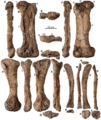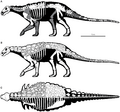Europelta facts for kids
Europelta is an extinct genus of nodosaurid dinosaur. It lived during the Early Cretaceous period. This was about 113 to 100.5 million years ago. It was found in northeastern Spain. The only known species is Europelta carbonensis. It is the most complete ankylosaur fossil ever found in Europe.
Contents
Discovering Europelta
This dinosaur was first described in 2013. Its name, Europelta, means "Europe's shield". This refers to its armored body and where it was found. The species name, carbonensis, honors the coal mining region. This area in Spain is called the Escucha Formation.
What Kind of Dinosaur Was It?
Europelta was a type of ankylosaur. Ankylosaurs were plant-eating dinosaurs. They were known for their heavy armor. Europelta belongs to a group called nodosaurids. Nodosaurids had bony plates, called osteoderms, all over their bodies. These plates acted like a tough shield.
A Spiky Shield
Imagine a dinosaur covered in bony armor. That's what Europelta was like! It had many osteoderms. These were different shapes and sizes. Some were flat, while others were spiky. This armor helped protect it from predators. It was like wearing a natural suit of armor.
Where Did Europelta Live?
Europelta lived in what is now northeastern Spain. This area was very different millions of years ago. It was a swampy, coastal environment. There were many plants for Europelta to eat. Other dinosaurs and animals also lived there.
The Escucha Formation
The fossils of Europelta were found in the Escucha Formation. This is a special rock layer. It tells us a lot about the Early Cretaceous period. Scientists found many bones from two different Europelta individuals. This made it the most complete ankylosaur from Europe.
Images for kids
See also
 In Spanish: Europelta carbonensis para niños
In Spanish: Europelta carbonensis para niños










